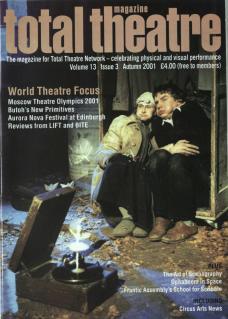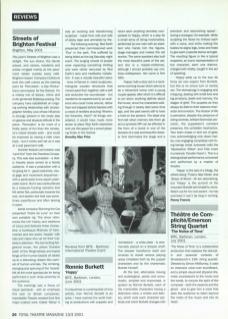This year's Streets of Brighton was a delight. The sun shone, the bands played, and visitors, residents and artists mingled merrily at the pavement tables outside every café. Brighton-based Company:Collisions took this café culture as the starting point for Percolator, a Zap Productions commission for the festival. It's a cheery mix of dance, mime and multi-gendered flirtatious posing The company have established an ongoing working relationship with choreographer Shelley Love whose influence is strongly present in the lovely play on gesture and physical attitude in the piece. Percolator is far more of a frothy piece of fun than the company's indoor theatre work and could be improved by having a little more body but it works well set as it was at a real pavement café.
Another festival commission was Land Hol from the Faceless Company. This was less successful – a static theatre piece aimed at a family audience. It was a production with a lot going for it – good costumes, visual gags and movement sequences with a particularly funny spoof underwater scene. But it was overburdened by a treasure-hunting narrative that fell rather flat, particularly towards the end, and spoken text that was sometimes superfluous and often lacking in pace.
Aerial company Skinning the Cat presented Claire de Lune on their own portable rig. The show references the rich history and traditions of circus and features three characters: a burlesque Mistress of Ceremonies and two exotic 'beasts' with tails and claws who vie for their mistress' attention. The tormenting fairground music, the yellow Trickster teeth of the Ringmistress and bared fangs of the human beasts all added up to a disturbing, dream-like carnival of human animals. The climbing, swinging and spinning of the ‘beasts' felt all the more spectacular for being performed in such close proximity to the audience.
The evenings saw a focus on visual spectacle – with an emphasis this year on British companies. Improbable Theatre created their first major outdoor work. Called Sticky it was an evolving and transforming sculpture – made from rolls and rolls of sticky tape and animated by fire.
The following evening, Red Earth presented their commissioned work Flux in the park. This suffered by being billed as the big Saturday night event. The surging crowds of people were expecting something thrilling and were rather bemused by Red Earth's slow and meditative installation. It was a visually beautiful piece – lines of flames in metal sculptures, triangular wooden structures that moved apart then together, with a soft and seductive live soundscape – but needed to be experienced by an audience who could move around, rather than one trapped behind barriers with a crowd of revellers shouting 'Where's the fireworks, then?' All things considered, it would have made more sense to place Red Earth elsewhere and use this space for a crowd pleasing finale to the festival.

